Yamaha PSR F51 Keyboard Review
We rated the Yamaha PSR F51 a 6.5/10. We had to take a few points off, because of the lack of recording, USB to MIDI port, and pedal input. We really wish the was some sustain on this instrument. Another area that was lacking was the keybed – There is no weight or touch sensitivity. However, there are still a handful of solid features on the F51, such as over the over 100-sound sound bank, and on-board rhythms. This is a good piano – But if you have a serious student, prepare to upgrade sooner rather than later.
$100.00
We rated the Yamaha PSR F51 a 6.5/10. We had to take a few points off, because of the lack of recording, USB to MIDI port, and pedal input. In fact, we really wish there was some sustain on this instrument. Another area that was lacking was the keybed – There is no weight or touch sensitivity. However, there are still a handful of solid features on the F51, such as over the over 100-sound sound bank, and on-board rhythms. This is a good piano – But if you have a serious student, prepare to upgrade sooner rather than later.
Overview

The Yamaha PSR F51 is a 61-key keyboard aimed at entry-level players. For children and beginners this is enough to get started with. Its sleek design and easy to use control panel makes it simple to learn the basics and get playing.
There are three important drawbacks to know about this keyboard. It can’t be connected to a computer as there’s no USB jack, there’s no recording facility and you can’t connect a sustain pedal as there’s no pedal input jack.
Not having a pedal isn’t a problem at all for young children who are just starting out on the piano. Usually they can’t reach the pedal anyway and they need to learn the notes and note reading first. But for an adult it can be limiting to play without being able to sustain any of the notes. There is in fact a Sustain button on the front panel of the F51, but it requires pushing at just the right moment, and has to be pushed again to release the sustain. This would be workable when playing something very simplistic but anything with fast changing chords and melody would make it very difficult to operate effectively. Having a foot pedal is a far better option.
The lack of recording capability also isn’t really a problem, but the fact that so many other keyboards do have recording capability is just something to keep in mind.
Regarding the lack of connectivity. If you’re looking for a keyboard for a child who’s an absolute beginner, this won’t be much of a problem. But consider that being able to connect to a computer – or connect a device – gives you access to a number of teaching apps. So depending on how the student is planning to learn, it’s something to keep in mind. There are other keyboards in this price-range that come with USB connectivity.
Keyboard
The PSR F51 has 61 standard size keys. They are non-weighted and non-touch-sensitive, as you would expect from this price point and design. These keys are absolutely fine for children who want to try piano and get creative on a keyboard. Once they start proper lessons, they will need to upgrade to at least semi-weighted keys, but they could get up to a year or so use out of this keyboard.
For adults, this keyboard might be a bit underwhelming, but if this is what’s available and you want to get started, it can do the job to some extent. You might have some fun with all the different sounds.
Sound
The Yamaha PSR F51 keyboard comes with 120 different instrument sounds as well as 114 Styles (meaning rhythm backings). There are 30 preset songs. The sound is produced through the 2 2.5W speakers. For its size, and the fact that it’s an entry level keyboard, this is plenty for an average size room. If you need more volume you can connect an amplifier by using the headphone jack.
Features
Voices
The PSR F51 comes with 120 different voices which include three types of piano and a harpsichord, three electric pianos, five organs, eight types of guitar and one ukulele. There are various strings – low, high, mid-range and an orchestral harp. A fair selection of world instruments including kalimba and dulcimer. The sounds themselves are just ok. For the price you’re not going to get great quality, but again, for a beginner and especially children, they are adequate.
Styles (Rhythms)
The Styles are divided into categories such as Dance & Disco, Trad and Waltz, Pop & Rock, Pianist, etc. Within that you’ve got Hard Rock, Rock Shuffle, Foxtrot, Salsa, 8-beat Piano Ballad, and so on.
Built-in songs
There are 30 built-in songs in the Yamaha PSR F51. These include famous pieces by classical composers such as Chopin and Bach, some traditional songs and a small selection of Christmas songs.
Duo Mode
Duo mode splits the keyboard into two half-size keyboards that have the exact same tones. This can be fun for duetting or for lessons with a teacher. It can be confusing if a teacher demonstrates a melody in one octave and the student plays it and it sounds in a different octave. This way, it can sound identical.
Split mode
This keyboard comes with pre-selected split voices. Certain instrument numbers when selected will give you one for the lower end of the keyboard and a different voice for the higher notes. For instance, selecting 114 will give you an acoustic bass sound for the left hand and a jazz piano sound in the right hand. 115 will give you electric piano in the upper keys with an electric bass in the lower end. Others are a selection of brass, woodwinds and saxophones.
Transpose function
This keyboard can transpose -12 to +12, useful if you have learned a song in a certain key and need to play it in a higher or lower key. This way you can play the same notes you normally play, but it will sound higher or lower, depending on your transpose selection.
Fine Tuning function
This detunes the piano in tiny increments. Useful if you’re playing with someone who can’t get their instrument to concert pitch. On a keyboard of this level, it’s a slightly strange function to include. It’s unlikely this would be useful to a child or adult beginner.
Sustain button
There is no sustain pedal jack on this keyboard but there is a “sustain button”. This means that if you want the notes to ring out for longer after you’ve played them, you will need to press the sustain button. When you want to notes to stop, you have to tap the button again to stop them ringing out. Normal sustain happens with a foot pedal keeping the hands free to continue playing. So this function is unlikely to be very useful. If you need a real sustain function, there are plenty of keyboards that come with a sustain pedal jack that would be far better.
Specifications

- The PSR F51 comes with a power adapter in most areas, but doesn’t in some locations, so check with your local dealer to be sure.
- Comes with music stand which fixes onto the front panel.
- Headphone jack
- Also runs off 6 X AA batteries
- 120 voices/114 rhythms/30 preset songs
Who Is It Suitable For?
Beginner
The Yamaha PSR F51 keyboard is designed and built for beginners – particularly children. It’s a good choice if you want to lay out a small amount of money to see if you or your child is going to enjoy the piano. The sound is adequate and the selection of different sounds is enough to generate quite a lot of fun. But be prepared – if you or your child advance on the piano, you’re going to need to upgrade fairly quickly.
Experienced and serious pianists
This keyboard isn’t going to satisfy any pianist from low-intermediate and up. The lack of weighted keys or even touch-sensitivity would be very frustrating. Even if this could be connected to a computer as a midi controller, this wouldn’t be very satisfactory – there are much better options.
Pros and Cons

Pros
- Reasonable for the price point
- Very portable
- Would inspire interest and creativity
Cons
- No connectivity for hooking up to a computer
- No sustain pedal jack
- Record facility unavailable
Quick View
| Keys | 61 unweighted |
| Touch sensitivity | No touch sensitivity |
| Sounds | 120 voices + 114 rhythms + 30 built-in songs |
| Recording capabilities | No record capability |
| Metronome | Built-in metronome |
| Polyphony | 32 notes can be played/sustained at once |
| Speakers | Built-in speakers 2.5W X 2.5W |
| Headphones | 1 headphone jack |
| Accessories | Music rest and power cable (although check with your supplier if they come along in your area). |
| Price point | $100 |
| Weight and Dimensions | 7lbs 8oz
37 X 12 X 4 |
Conclusion
The Yamaha PSR F51 keyboard is a sophisticated toy piano designed for children to get their first taste of playing the piano and making dance tracks. The unweighted non-touch-sensitive keys will limit a child’s progress on the piano after the first 6 to 12 months, depending on their age and how seriously they pursue playing. If a beginner plays on an unweighted keyboard for too long, there is a chance they’ll have difficulty transferring to a weighted keyboard (or acoustic piano) as the action is so different. In order to build good hand position and finger action, it’s best to have weighted keys as early as possible.
This would make a great gift for a child and a lot of fun could be had on it. It’s a shame that it can’t be connected to a computer to give a selection of learning opportunities. The lack of a sustain pedal jack and recording capability also lowers the value of this keyboard. Other keyboards in this price range – or slightly higher – offer more functions and some have better quality sound. As an example, the Casio CT S200 is another keyboard in this category that has better quality sounds and functions more usefully overall.


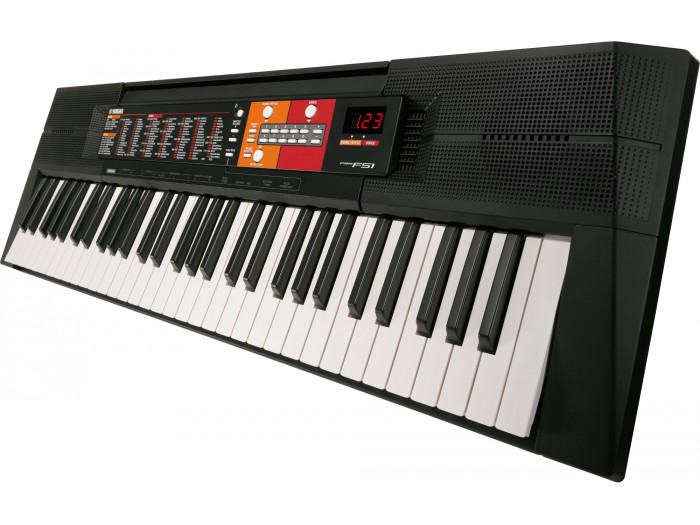
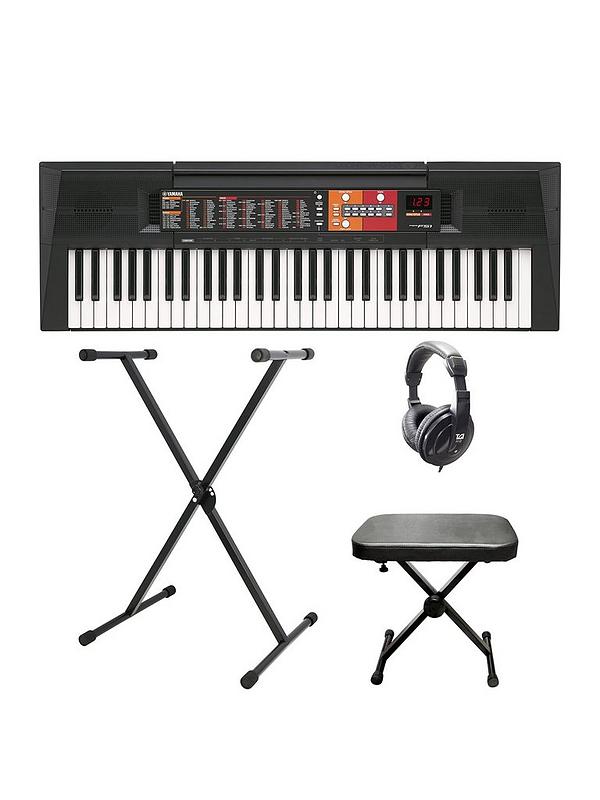
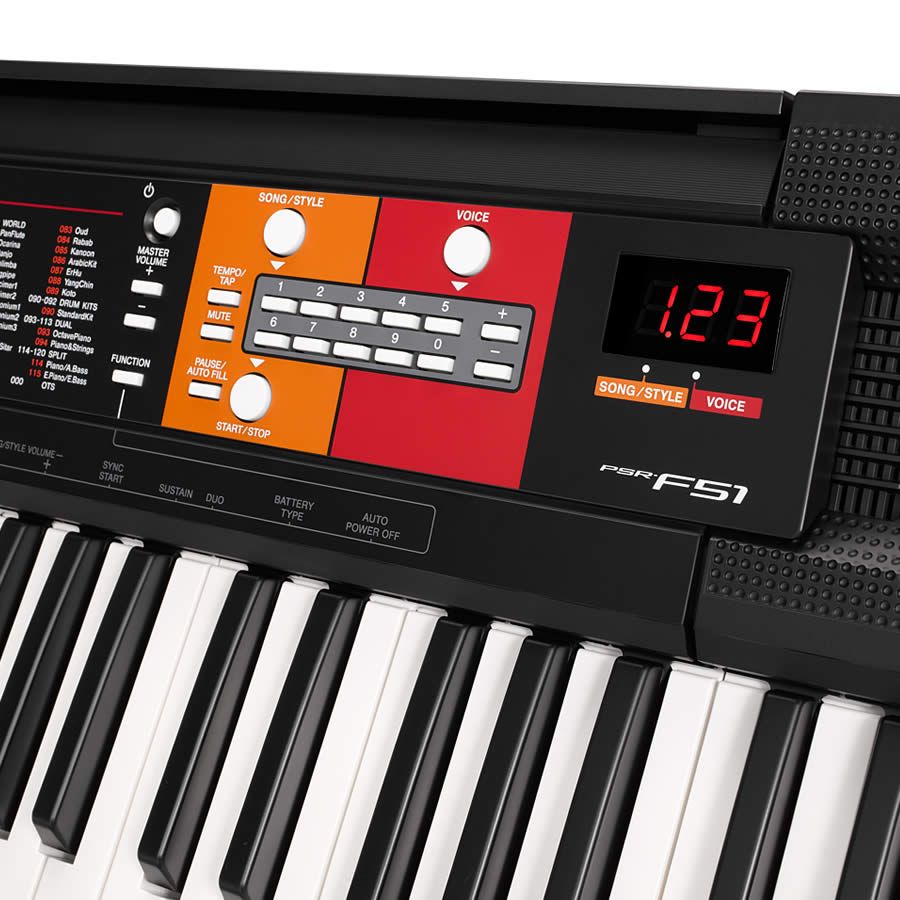
 We rated the Yamaha PSR F51 a 6.5/10. We had to take a few points off, because of the lack of recording, USB to MIDI port, and pedal input. We really wish the was some sustain on this instrument. Another area that was lacking was the keybed - There is no weight or touch sensitivity. However, there are still a handful of solid features on the F51, such as over the over 100-sound sound bank, and on-board rhythms. This is a good piano - But if you have a serious student, prepare to upgrade sooner rather than later.
We rated the Yamaha PSR F51 a 6.5/10. We had to take a few points off, because of the lack of recording, USB to MIDI port, and pedal input. We really wish the was some sustain on this instrument. Another area that was lacking was the keybed - There is no weight or touch sensitivity. However, there are still a handful of solid features on the F51, such as over the over 100-sound sound bank, and on-board rhythms. This is a good piano - But if you have a serious student, prepare to upgrade sooner rather than later. 




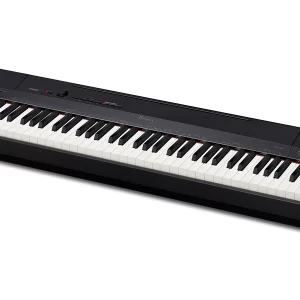
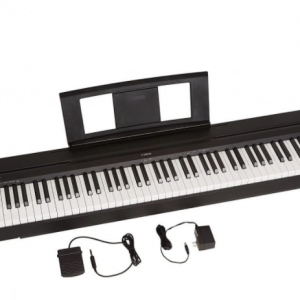
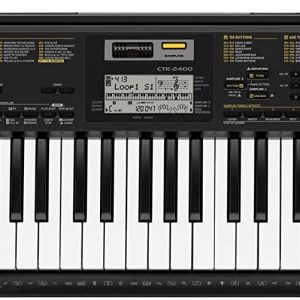
There are no reviews yet.